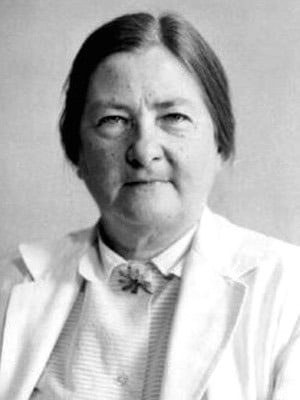Dorothy H. Andersen

Dorothy Hansine Andersen (1901-1963) was an American pediatrician and pathologist.
Andersen was a pioneering American physician, pathologist, and medical researcher whose name is indelibly linked with the first clinical recognition of cystic fibrosis. Working at a time when few women held senior roles in academic medicine, Andersen combined sharp diagnostic acumen with tireless investigative curiosity. Her 1938 landmark publication redefined a subset of previously misdiagnosed children with coeliac-like symptoms and recurring pulmonary infections, establishing cystic fibrosis of the pancreas as a unique clinical and pathological entity.
Andersen’s work extended far beyond description. She developed diagnostic enzyme assays, identified salt loss as a feature of CF, and laid the groundwork for the sweat test, transforming the disease from an autopsy diagnosis to a clinical one. Her contributions with Paul di Sant’Agnese and others enabled earlier detection and systematic characterisation of the disease, directly influencing treatment approaches and life expectancy. In 1956, she also described Andersen disease (glycogen storage disease type IV), further underscoring her impact on paediatric pathology and metabolic disease.
A skilled teacher and researcher, Andersen became the first woman to be appointed full professor at Columbia University’s College of Physicians and Surgeons in pathology. She was known for her wit, unflinching standards, and fierce dedication to her patients. Despite facing significant gender barriers, she gained widespread recognition in her lifetime, receiving awards including the Borden Award and the Elizabeth Blackwell Citation. Dorothy Andersen’s legacy is one of meticulous science, compassion, and perseverance and her work remains foundational to paediatrics, genetics, and cystic fibrosis care worldwide.
Biographical Timeline
- Born on 1901 – Born May 15 in Asheville, North Carolina, to Danish immigrant Hans Peter Andersen and Mary Louise Mason. 15, 1901 in Asheville, North Carolina
- 1922 – 1922 – Graduated with a Bachelor of Arts in chemistry and zoology from Mount Holyoke College. of Arts in chemistry and zoology at Mount Holyoke College
- 1922–1926 – Attended Johns Hopkins School of Medicine; one of six women in her class. Conducted early research with Florence Rena Sabin (1871–1953) and published embryological studies on female pig reproductive anatomy.
- 1926–1927 – Completed surgical internship at Strong Memorial Hospital, University of Rochester, NY; denied residency due to gender.
- 1928 – Surgical intern at the Strong Memorial Hospital but denied residency on the basis of her gender.
- 1929 – Assistant in Pathology at the faculty of the College of Physicians and Surgeons of Columbia University
- 1930 – Awarded Doctor of Medical Science degree. Became instructor in pathology at Columbia; began work on endocrine and reproductive pathology.
- 1935 – Professor of pathology at the the Babies Hospital at Colombia–Presbyterian Medical Center; Doctor of Medical Science, Columbia University.
- 1938 – Published landmark paper “Cystic fibrosis of the pancreas and its relation to celiac disease” in Am J Dis Child, establishing cystic fibrosis as a distinct clinical entity.
- 1942 – Developed diagnostic assay of pancreatic enzymes in duodenal juice to diagnose cystic fibrosis.
- 1948 – awarded the Borden Award for research in Nutrition.
- 1952 – Received the Elizabeth Blackwell Award for Women in Medicine; appointed Chief of Pathology at Babies Hospital.
- 1953 – Work with Paul di Sant’Agnese led to development of the sweat test for CF diagnosis (published by Gibson & Cooke in 1959).
- 1958 – Appointed full professor of pathology at Columbia University.
- Died on March 3, 1963 in New York; heavy smoker died of lung cancer aged 61
- 2002 – Posthumously inducted into the National Women’s Hall of Fame.
Medical Eponyms
Cystic Fibrosis (1938)
Cystic fibrosis (CF) is a common autosomal recessive disorder affecting epithelial ion transport, caused by mutations in the CFTR gene. It leads to viscous secretions in the lungs, pancreas, and other organs, resulting in chronic respiratory infections, pancreatic insufficiency, malabsorption, and elevated sweat chloride. The condition is now routinely screened in newborns and managed through multidisciplinary care.
1938 – First described cystic fibrosis of the pancreas as a distinct clinicopathological entity. In a landmark study of 49 autopsy cases, she noted the triad of:
- Fibrotic pancreatic changes with cystic dilation of ducts
- Recurrent pulmonary infections (bronchitis, bronchiectasis, abscesses)
- Vitamin A deficiency and congenital GI anomalies
Pancreatic acini replaced by epithelium-lined cysts and surrounded by fibrous tissue… recurrent lobar pneumonia and Staph. aureus infection were common.
Andersen DH, 1938
1942 – Andersen introduced measurement of trypsin in duodenal juice to diagnose pancreatic insufficiency, refining diagnostic capability. Both lipase and amylase assays were found to be less reliable.
Trypsin levels were found to be the most reliable indicator of pancreatic deficiency.
Andersen DH, 1942
1951 – During a 1948 New York heatwave, Andersen and Walter R. Kessler (1913-1978) reported that children with CF suffered heat prostration, pointing to electrolyte loss as a critical pathophysiologic feature.
1953 – Andersen, with Paul di Sant’Agnese and others, demonstrated that sweat chloride concentrations were markedly elevated in children with CF. Sweat from nine CF children and eight controls showed chloride more than three times higher in the people with CF than in the controls.
Chloride concentrations were more than three times higher in CF children than in controls.
Darling et al., 1953
1959 – Gibson and Cooke, building on Andersen’s discoveries, published the pilocarpine iontophoresis sweat test, which became the diagnostic gold standard.
Andersen disease (1956) [Glycogen Storage Disease Type IV (GSD IV)]
Andersen disease is a rare autosomal recessive glycogen storage disorder caused by deficiency of the glycogen branching enzyme (GBE1). This results in the accumulation of abnormal, poorly branched glycogen (polyglucosan bodies) in liver and muscle tissues, leading to hepatosplenomegaly, progressive liver cirrhosis, hypotonia, and early death in infancy.
1956 – Andersen described the condition in a series of infants with hepatomegaly, failure to thrive, and cirrhosis, with histological findings of abnormally structured glycogen in her publication Familial cirrhosis of the liver with storage of abnormal glycogen
Pathophysiology:
- Mutation in GBE1 gene → deficient branching enzyme
- Poorly branched glycogen → insoluble deposits in tissues
- Most common form: hepatic subtype with liver failure by age 5
- Neuromuscular forms also exist (adult polyglucosan body disease)
Modern management:
- Supportive care: nutritional support, management of liver failure
- Liver transplantation: curative for hepatic form
- Molecular diagnosis: GBE1 sequencing confirms diagnosis
- Carrier detection and genetic counselling
Major Publications
- Andersen DH. Lymphatics and blood vessels of the ovary of the sow. Contributions to Embryology. 1926; 17(88): 107-122
- Andersen DH, Sperry WM. A study of cholesterol in the adrenal gland in different phases of reproduction in the female rat. J Physiol. 1937 Aug 17;90(3):296-302.
- Andersen DH. Cystic fibrosis of the pancreas and its relation to celiac disease. A clinical and pathological study. American Journal of Diseases of Children, 1938; 56: 344-399. [cystic fibrosis]
- Andersen DH. Pancreatic enzymes in the duodenal juice in the celiac syndrome. Am J Dis Child. 1942;63(4):643-658 [cystic fibrosis]
- Kessler WR, Andersen DH. Heat prostration in fibrocystic disease of the pancreas and other conditions. Pediatrics. 1951;8(5):648-656.
- Darling RC, di Sant’Agnese PA, Perera GA, Andersen DH. Electrolyte abnormalities of the sweat in fibrocystic disease of the pancreas. Am J Med Sci. 1953; 225(1): 67-70
- Andersen DH. Studies on glycogen disease with a report of a case in which the glycogen was abnormal. In: A Symposium on the Clinical and Biochemical Aspects of Carbohydrate Utilization in Health and Disease. Edited by Najjar, V. A. Baltimore, 1952. Johns Hopkins Press.
- Andersen DH, Di Sant’Agnese PA. Idiopathic celiac disease. I. Mode of onset and diagnosis. Pediatrics. 1953;11(3):207-223.
- Andersen DH. Familial cirrhosis of the liver with storage of abnormal glycogen. Lab Invest. 1956; 5(1): 11-20. [Andersen disease]
References
Biography
- Damrosch DS. Dorothy Hansine Andersen. J Pediatr. 1964;65:477-479.
- Clague S. Dorothy Hansine Andersen. Lancet Respir Med. 2014;2(3):184-185.
- Gerais R. Dorothy Andersen (1901–1963). Embryo Project 2017
- Gilpin D, Tunney M, Elborn S. Dorothy Hansine Andersen. QUB
- Aydelotte A. Andersen, Dorothy Hansine. American National Biography
Eponymous terms
- Gibson LE, Cooke RE. A test for concentration of electrolytes in sweat in cystic fibrosis of the pancreas utilizing pilocarpine by iontophoresis. Pediatrics. 1959;23:545–99.
- Thomas E, Aziz-Donnelly A, Garcia-Santibanez R. Women in the History of Neuromuscular Medicine. Neuromuscular Disorders. 2019; 29: 698-703
- Marsden, Deborah. “Andersen Disease (GSD IV)”. NORD (National Organization of Rare Diseases).
Eponym
the person behind the name
Studied at University of Leeds-MBChB and Microbiology in Relation to Medicine BSc. British doctor currently working in Emergency Medicine in Perth, Australia.
BA MA (Oxon) MBChB (Edin) FACEM FFSEM. Emergency physician, Sir Charles Gairdner Hospital. Passion for rugby; medical history; medical education; and asynchronous learning #FOAMed evangelist. Co-founder and CTO of Life in the Fast lane | On Call: Principles and Protocol 4e| Eponyms | Books |

